

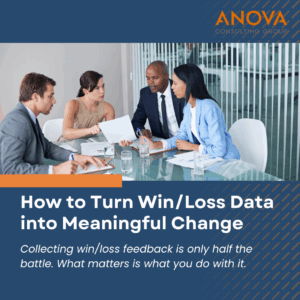 Part 4: Acting on Win / Loss Data: Moving from Insight to Impact
Part 4: Acting on Win / Loss Data: Moving from Insight to ImpactAfter win / loss data has been collected, getting value from the research will ultimately come down to what is done with the research. There are many ways to do this, stretching from short term to ongoing, long-term actions.
In the short term, use individual data points as coaching opportunities. Feedback from individual situations can be used to color in blind spots of what happened in a specific deal so that sellers can learn and improve for their next opportunities.
In the medium term, after multiple interviews have been completed, identify and discuss emerging trends. When discussing these aggregate findings, do so in a cross-functional environment so that team members from product, sales, marketing, and other parts of the organization can share their perspective on why certain trends are beginning to appear. There may be initial findings with deeper truths, or they might be red herrings, but the cross-functional discussion will help promote collaboration and alignment across teams no matter what the finding is.
Over the long term, as sample sizes reach levels where the findings can be acted on, look not only to uncover insights, but identify key takeaways. Assign action owners responsible for driving change based on key takeaways. As more interviews are completed, look to see any changes in sentiment from prospects that will indicate whether or not you have moved the needle.
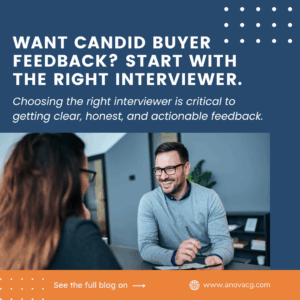 Part 3: Choosing Internal vs. Third-Party Interviewers
Part 3: Choosing Internal vs. Third-Party InterviewersOn your win / loss journey, once you know who you are going to talk to (prospect identification) and what you are going to talk to them about (interview guide design), the next decision is who will be talking to them.
The most fundamental question is whether to use internal resources or to rely on third-party interviewers. Each option has benefits. To decide which is the best option, consider these elements:
• Product expertise: The goal is to have the interviewee feel like they are having an intelligent conversation with someone who understands their business. No one will know your product more than internal resources, but highly trained third-party interviewers are often preferable as they are unbiased and therefore less likely to distort or influence the buyers perspective.
• Interviewing expertise: Interviewing is an art form. With the ultimate goal of collecting the breadth and depth of information necessary to take action, deploying interviewers who are skilled in asking questions and encouraging respondents to provide more detail can be the difference between a program that “checks the box” and one that can be used to drive strategic decisions. Among these skills are probing, being curious, using silence as a way to get the interviewee to fill the space and provide more detail, and also making the interviewee comfortable enough so that they do open up and provide more than surface level answers.
• Bandwidth: Particularly when thinking about a robust program consisting of dozens of interviews, bandwidth is an important consideration. It is not just the time to conduct the interviews either. Having dedicated time to reach out to schedule interviews is necessary to ensuring strong response rates. Writing up the transcript also takes time. Even if you are using AI to help with the transcription, the dialogue should still be reviewed and edited for clarity. This is where third parties can be a major value-add, as completing the interviews is their sole focus, as opposed to internal resources who likely have other competing priorities.
• Objectivity: Lastly, but perhaps the most important factor to consider, is objectivity. Anova’s research indicates that 60% of the time a salesperson does not get the full and accurate truth as to why they won or lost a deal if they debrief with a prospect themselves. This doesn’t mean a salesperson is doing anything nefarious. Prospects may be reluctant to give the person direct and honest feedback. Having someone internal who is removed from the situation (e.g., product manager / marketer) is a good way of increasing objectivity, and using a third party is the best way to obtain unbiased, independent feedback.
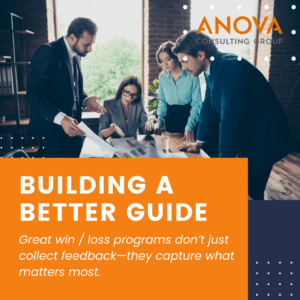 Part 2: Designing the Right Interview Guide
Part 2: Designing the Right Interview GuideCritical to win / loss program success is capturing the right information. Win / loss is a powerful tool in part because of the breadth of customer feedback it can collect. It is normal for feedback to cover sales, product, pricing, services, brand / market positioning, and of course competitive comparisons.
In a perfect world companies would be able to collect as much feedback as possible across all these areas in each interview, however respondents don’t have unlimited time to give. This makes interview guide design really an optimization exercise.
To maximize a program’s value, questions should be aligned to the biggest areas of focus that were identified by stakeholders in the buy-in stage. This will ensure that above all else, feedback is maximized in those influential areas that are most responsible for driving wins and losses.
Beyond concentrating on those critical areas of focus, interview guide design should also achieve a balance between the following types of questions:
One last thing to consider: the interview guides shouldn’t be set in stone. As you collect feedback and/or your business priorities change, adapt the guide so you are constantly optimizing your feedback loop.
Ultimately, win / loss interview guides can take all shapes and forms. With a little thought into areas you want to focus on, and a balanced approach for collecting feedback, the guide can be a vital tool for collecting actionable feedback.
 After over 20 years of working with companies to help them implement and build successful win / loss programs, we’ve heard every question under the sun. This series will explore the areas we often get asked about the most.
After over 20 years of working with companies to help them implement and build successful win / loss programs, we’ve heard every question under the sun. This series will explore the areas we often get asked about the most.
As with many things in life, “it depends” is a common answer we resort to. Rarely is there a one size that fits all or off-the-shelf blueprint for win / loss program success. However, there are frameworks and things to keep in mind to help you navigate these common areas of curiosity.
Part 1: Getting Executive Buy-In for Win/Loss Analysis
Getting Executive Buy-In is firmly entrenched in the curriculum of “Win / Loss 101”. And yet, it is a step that many organizations try to skip or treat as a check the box exercise. Even for the companies who really understand its importance, there is the question of how to effectively involve senior stakeholders with the program. This blog will explore both why executive buy-in is important, as well as how to get it.
Why Executive Buy-In is Important:
Think of a plane taking off on a cloudy day. Typically, there is some turbulence before the plane reaches its cruising altitude. Similarly, a win / loss program will run more smoothly if it reaches the clearer air space of the highest rungs of an organization.
A win / loss program is a great example of “you get what you put in”. Strong efforts will yield strong results. In a world of competing priorities, knowing that stakeholders are behind the program and are looking for results from it helps to ensure the required levels of attention are paid to the program to ensure success.
Said differently, executive buy-in can be a good carrot. It can also be a good stick to ensure program compliance from sellers to ensure they are not dodging the program or not providing accurate contact information to collect feedback. When an executive makes it known the program is not optional, and the results will not be used as a “witch hunt” but to help the entire organization improve and win more, the raw inputs (buyer contact information) are easier to access.
Executive buy-in also positively impacts the smoothness of other program operations:
Getting Executive Buy-In
Now the part that has many organizations struggling: truly getting executives to buy-in.
In general, the best way to secure executive support is by aligning the program to their areas of interest. This can be in terms of who you talk to (executives tend to care about the biggest customers, or maybe your organization is rolling out a new product and they want initial feedback from those early adopters) as well as what you talk to them about (head of sales interested in how effective you were at differentiating against the competition? Make sure to ask about that specifically).
Be sure to also tailor your communication to the individual stakeholder you are interfacing with. When talking with sales leaders, emphasize how win / loss can positively impact win rates (Gartner says by up to 50%). When talking to the CMO, highlight how the research will help refine messaging and collect competitive insights. When working with the CEO or head of the business, be sure to note how the program will help ensure strong levels of customer centricity, as well as build strong internal cultures by accentuating values such as a growth mindset and commitment to feedback.
 Building and Leveraging Your Network: The Power of Trust and Brand
Building and Leveraging Your Network: The Power of Trust and Brand
Your network isn’t just a list of connections—it’s a critical driver of business growth. In every industry, success depends on how well you cultivate relationships, establish trust, and position your brand. But trust and brand don’t operate the same way in every market.
In mature industries, trust built over time plays a key role in decision-making, while in fast-moving, innovation-driven markets, brand credibility and cutting-edge solutions take priority. Understanding these nuances allows businesses to accelerate growth, close deals more effectively, and strengthen long-term customer relationships.
To maximize your network’s impact, you need a strategy that not only builds connections but also leverages them for real business outcomes.
The Role of Trust in Business Networks
Trust is the foundation of any successful relationship, personal or professional. But in business, the weight of prior relationships differs depending on the type of market you operate in.
Building Your Brand to Strengthen Your Network
Your brand is an extension of your reputation, and in many cases, it plays a pivotal role in growing and maintaining a strong business network. However, the impact of brand also varies between market types.
Using Your Network to Strengthen Relationships and Drive Growth
Building a network is only the first step—leveraging it effectively is what drives sustained growth. Here are a few key strategies for using your network to strengthen relationships and expand your reach:
A strong network is built on trust, strengthened by brand reputation, and expanded through strategic engagement. Understanding how these factors influence decision-making can refine your approach, deepen your relationships, and accelerate growth in any market.
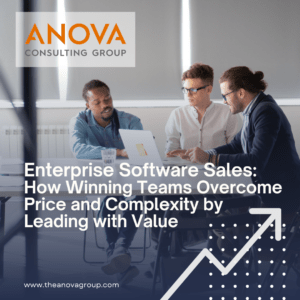
Why do enterprise software sales teams win and lose deals? Traditional thinking would hypothesize that for high-dollar value, complex software platforms, the strength of their solution drives wins while losses are driven by a perception of higher price points and more difficult implementations, especially compared to less robust, cheaper, point solutions. Does the difference between winning and losing truly come down to price and a perception of being easy to work with? If that thinking holds true, how can enterprise software companies win despite being perceived as more expensive and more difficult to implement than their competitors?
This report explores how in enterprise software deals, winning in these competitive situations is predicated more on demonstrating value rather than absolute cost or perception of effort involved. In order to fully examine this, Anova analyzed findings from thirteen win / loss programs conducted between 2022 and 2023 focused on complex, high value enterprise software deals. Our goal was to understand what winning sales teams do differently to set their solutions apart and ultimately win more. Company names in this case study have been scrubbed and will be referred to as the Client.
In those thirteen programs one of the most interesting findings was that when our Client won, in just over half of those winning situations their newly acquired customer was actually more satisfied with a competitor’s price point. Despite being at a pricing disadvantage, the Client was still able to win because they proved their solution would drive superior value for the customer. Conversely, when we looked at the inverse loss data, 100% of the time when our Client lost customers rated themselves as more satisfied with both price point and expected value.
Figure 1 illustrates one specific situation representative of this finding. When this Client won, satisfaction with its value exceeded that of its top competitor (75% versus 50%), even though it fell behind its competitor in terms of satisfaction with price levels (50% versus 100%). In contrast, when the Client lost, the winning vendor outperformed it in both value satisfaction and pricing satisfaction.
Figure 1 Satisfaction with Price Levels and Value in Wins and Losses Between Clients and Competitors

Additionally, in our Clients’ winning situations, an average of just 48% of prospects were satisfied with their expected ease of implementation. Said another way, more than half of newly won customers expected to be dissatisfied with their selected vendor’s implementation process yet still felt that value of the implemented solution would outweigh the pain of installation.
It becomes clear that the expectation of high value can outweigh pricing and implementation concerns. So, the question then becomes: how can software sales teams become successful at proving their value to their customers?
Click here to read the full case study.
 For sales leaders, success is not just about hitting quotas – it is about understanding why you are winning or losing deals. In today’s hyper-competitive market, the ability to analyze external factors such as competitor moves, customer preferences, and shifting market dynamics is what separates high-performing sales teams from the rest.
For sales leaders, success is not just about hitting quotas – it is about understanding why you are winning or losing deals. In today’s hyper-competitive market, the ability to analyze external factors such as competitor moves, customer preferences, and shifting market dynamics is what separates high-performing sales teams from the rest.
Businesses today have great internal visibility – into their Pipelines, CRM data, internal performance metrics and roadmaps but many are flying blind when it comes to understanding and acting on what’s happening externally – with competitors, customers, and partners – most companies are radically underinvested.
Competitive Intelligence (CI) and Market Intelligence (MI) give sales teams the insights they need to sharpen their strategies, stand out from competitors, and improve close rates. So, how do you gather and use this intelligence effectively?
Why Competitive Intelligence Matters
Competitive Intelligence helps businesses stay ahead by providing real-time insights into market trends and competitor moves. With the right approach, you can:
How Win / Loss Analysis Strengthens Sales Strategy
Win / Loss Analysis isn’t just about tracking deals—it’s about uncovering what drives buyer decisions. A third-party debrief after a sale provides unbiased, actionable feedback that helps your sales team:
By continuously gathering insights from prospects and customers, businesses can make smarter adjustments to their sales process and improve performance over time.
Expanding Your Competitive Intelligence Approach
Competitive Intelligence goes beyond just reviewing lost deals. To get the full picture, companies should focus on:
Taking Action Now
If your sales team is only keeping score without understanding the reasons behind wins and losses, there is a huge opportunity being missed. Win / Loss Analysis is a crucial component of Competitive Intelligence, providing the detailed feedback needed to identify strengths, weaknesses, and areas for differentiation. By integrating Win / Loss insights with a broader Competitive Intelligence strategy, businesses can make data-driven decisions that enhance positioning, refine messaging, and ultimately, increase win rates.

Valentine’s Day is all about relationships—but some just aren’t worth holding onto. In business, that means it’s time to break up with outdated sales strategies, ineffective messaging, and misaligned assumptions that are holding your team back.
Here are five toxic habits we recommend leaving behind this quarter:
Relying on Internal Assumptions Instead of Customer Insights
Chasing Every Lead Instead of Prioritizing the Right Ones
Ignoring the Competition Until It’s Too Late
Using the Same Sales Pitch for Every Prospect
Letting Insights Go Unused

“How did we lose that deal?!” or “Why did our competitor win over us?” These are common questions sales leaders ask their teams, and they are fair questions—business leaders need honest answers to win the next deal.
When a salesperson asks a decision-maker why they won or lost a deal, the truth is often disguised or not shared at all. In fact, salespeople only know the exact reasons behind a decision 40% of the time. At Anova, we work to close this gap by conducting Win-Loss interviews as a neutral third-party. One of the key questions we ask is, “What were the top three reasons for your decision to choose the winning provider?”
By aggregating this feedback, a story emerges. Our analysis helps clients understand what they did well when they won and where competitors outperformed them in losses. This raised a key question for us: What do these stories tell us about the attributes that drive buying decisions?
Mature vs. Growth Markets
To answer this, we grouped companies into two categories:
When analyzing aggregate data, key trends emerged. The top five decision-making attributes with the greatest differences between these market types were:
The percentage of time each of those attributes were mentioned as a reason for choosing a provider can be seen in the table below:

This data reveals that there are real differences between the two industry types. If one were to rank the attributes in each market separately, price, brand and service are the three most important decision criteria in Mature industries, but price, sales, and brand have the most influence over decisions in Growth markets.
In summary:
Price is the most frequently mentioned attribute in each market and also has the widest disparity in mentions, signaling a difference in how influential costs can be.
The Unintended Consequences of Your Team’s Pursuit of Efficiency over Execution
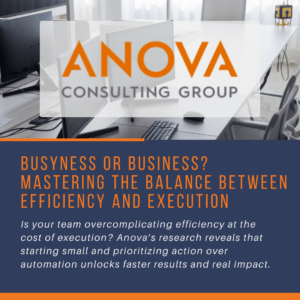 Accountability is the cornerstone of our team’s values, and we pride ourselves on delivering what we promise, when we promise. To ensure every team member embodies this value, we actively seek feedback from our own clients on their degree of satisfaction with Anova’s performance. Our year-end employee evaluations are tied to client satisfaction and program success. Despite consistently ranking in the top-performing quadrant, our team often faces challenges in one area: deal flow (defined as the number of new business contacts clients provide for win/loss phone interviews).
Accountability is the cornerstone of our team’s values, and we pride ourselves on delivering what we promise, when we promise. To ensure every team member embodies this value, we actively seek feedback from our own clients on their degree of satisfaction with Anova’s performance. Our year-end employee evaluations are tied to client satisfaction and program success. Despite consistently ranking in the top-performing quadrant, our team often faces challenges in one area: deal flow (defined as the number of new business contacts clients provide for win/loss phone interviews).
In today’s data-driven world, with the rise of advanced CRM software and generative AI, customer data seems abundant. As a result, clients often express confidence in their ability to provide customer contact information during our initial discussions. However, Anova’s experience with leading B2B companies tells a different story:
Short-term Focus on Efficiency:
Short-term Focus on Execution:
Anova’s experience has repeatedly confirmed that when clients seek efficiency through automation, they tend to overcomplicate the short-term mandate and end up delaying ROI. While automating deal flow submission should remain the long-term goal, if it’s going to delay getting into the field, our advice is simple: Focus on the most pragmatic short-term solution and just get started. Even if it’s only a couple of prospects from your top revenue opportunities to kick things off, the insights gained from these initial conversations will have measurable impact—certainly more impact than not executing at all.